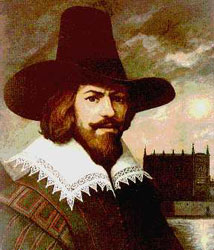| Guy Fawkes Night |

Image taken from montemaria.org
|
 Image taken from montemaria.org |
|
READ THE TEXT BELOW AND THEN CLICK ON THE LINKS ON THE RIGHT TO COMPLETE THE ACTIVITIES. Guy Fawkes Night is a very British celebration. It celebrates a failed attempt to blow up the Houses of Parliament (that’s where Big Ben is) in London. It all happened on November the fifth, 1605. A group of Catholics led by Robert Catesby, who were unhappy with their Protestant rulers, wanted to bring the government down. Their plan was to kill the king James I of England and VI of Scotland, as the prelude to a popular revolt in the Midlands during which James's nine-year-old daughter, Princess Elizabeth, was to be installed as the Catholic head of state. Difficult Times for Catholics English Catholics were very excited at the time. They had suffered severe persecution since 1570, when the Pope had excommunicated Elizabeth. The Spanish Armada of 1588 had made matters worse. To the Tudor State, all Catholics were potential traitors. They were forbidden to hear Mass, forced instead to attend Anglican services, with steep fines for those recusants who persistently refused. The protestant who refused to attend protestant churches were known as recusants. The Gunpowder Plot The Gunpowder plot was led by Robert Catesby. His fellow plotters were John Wright, Thomas Wintour, Thomas Percy, Guy Fawkes, Robert Keyes, Thomas Bates (who was Robert Catesby’s servant), Robert Wintour, Christopher Wright, John Grant, Sir Ambrose Rookwood, Sir Everard Digby and Francis Tresham. Fawkes, who had 10 years of military experience fighting in the Spanish Netherlands in suppression of the Dutch Revolt, was given charge of the explosives. Their first meeting was on 20 May 1604 at the inn the Duck and Drake, in the Strand. Guy Fawkes, who was originally from York, was installed as caretaker, under the alias of “John Johnson”. The Discovery The plot was revealed to the authorities in an anonymous letter sent to Lord Monteagle, on 26th October 1605. The letter is still kept in the Public Record Office. During a search of the House of Lords at about midnight on 4 November 1605, Fawkes was discovered guarding 36 barrels of gunpowder—enough to reduce the House of Lords to rubble—and arrested. Most of the conspirators were arrested. At their trial on 27th January 1606, eight of the survivors, including Fawkes, were convicted and sentenced to death. After the Plot It was ordinary Catholics, however, who suffered the longest as a result of the Gunpowder Plot. New laws were passed preventing them from practising law, serving as officers in the Army or Navy, or voting in local or Parliamentary elections. Furthermore, as a community they would be stigmatised for centuries. It was not until 1829 that they were again allowed to vote. Text adapted from the BCC and Wikipedia: http://www.bbc.co.uk/history/british/civil_war_revolution/gunpowder_robinson_01.shtml http://en.wikipedia.org/wiki/Gunpowder_Plot |
Links:
|